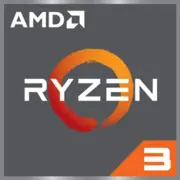AMD Ryzen 3 2200U

AMD Ryzen 3 2200U in 2025: Is it Worth Buying a Budget Laptop with This Processor?
Despite being released back in 2018, the AMD Ryzen 3 2200U can still be found in budget laptops priced between $300 and $450 by 2025. This processor is marketed as a solution for basic tasks, but how relevant is it today? Let's break it down in detail.
Architecture and Process Technology: A Hybrid of Zen and Vega
Raven Ridge: A Hybrid CPU and GPU
The Ryzen 3 2200U is built on the first-generation Zen microarchitecture with a 14 nm process technology. It is one of AMD's first mobile APUs (Accelerated Processing Units), combining two CPU computing cores and Vega graphics on a single chip.
- CPU Part: 2 cores / 4 threads thanks to SMT (Simultaneous Multithreading). Base clock speed – 2.5 GHz, maximum turbo mode – 3.4 GHz.
- GPU Part: Radeon Vega 3 with 192 shader processors and a clock speed of up to 1000 MHz. Supports DirectX 12, Vulkan, and FreeSync technology for smooth visuals in gaming.
- Cache and Memory: 4 MB of L3 cache, supports DDR4-2400 MHz in dual-channel mode (recommended for improving iGPU performance).
Architecture Features
Compared to modern APU Ryzen 5000/6000 series, the 2200U significantly lags in energy efficiency and IPC (instructions per clock). However, its advantage lies in low manufacturing costs, making it popular in ultra-budget laptops.
Power Consumption and TDP: Balancing Power and Battery Life
The processor's TDP is 15 W, which is typical for ultrabooks and thin devices. In reality, power consumption can vary from 12 W (light tasks) to 25 W (turbo mode under load).
Optimization Technologies
- Precision Boost: Automatically raises core frequencies when there is thermal headroom.
- Adaptive Power Management: Reduces voltage at idle, saving battery charge.
Heat Dissipation
Even in compact cases (like Acer Aspire 3 or HP 14-dk), the processor rarely overheats, but under prolonged load (like video rendering), the clock speed may drop to the base 2.5 GHz.
Performance: What Can the Ryzen 3 2200U Do in 2025?
Office Tasks
- Testing in Microsoft Office, Google Workspace: The processor handles documents, spreadsheets, and video conferences (Zoom, Teams) without lag.
- Multitasking: 8 GB of RAM + SSD is essential. Opening 10-15 tabs in Chrome along with messengers is possible, but may cause periodic slowdowns.
Multimedia
- 4K Video: Playback via YouTube or local files (VLC) is smooth, but hardware decoding only supports H.264. There may not be enough power for HEVC (H.265).
- Photo Editors: Basic retouching in Lightroom or Photoshop is doable, but filters and layers will be processed slowly.
Gaming
- eSports Games: CS:GO — 30-40 FPS at low settings (720p), Dota 2 — 25-35 FPS (720p).
- Indie Games: Hollow Knight, Stardew Valley — stable 60 FPS.
- Turbo Mode: Briefly boosts FPS by 10-15%, but due to TDP limitations, the effect lasts no more than 5-10 minutes.
Geekbench 6
- Single-Core: 770 (comparable to Intel Core i3-8130U).
- Multi-Core: 1521 (even lags behind budget Intel Core i5-1135G7 by 35-40%).
Use Cases: Who Is This Processor Suitable For?
- Students: For note-taking, online courses, and light presentations.
- Office Workers: Working with documents, emails, and spreadsheets.
- "Casual Users": Browsing YouTube, social media, and online shopping.
Not Suitable For:
- Video editing in DaVinci Resolve or Premiere Pro.
- Modern AAA games (Cyberpunk 2077, Elden Ring).
- Running virtual machines or heavy IDEs (Android Studio).
Battery Life: How Long Will the Laptop Last?
With a battery capacity of 40-45 Wh (typical for budget models), the runtime is:
- Web Browsing: 6-7 hours.
- Video (1080p): 5-6 hours.
- Maximum Load: 2-3 hours.
Energy Saving Technologies:
- Radeon Chill: Lowers frame rates in games when the user is inactive.
- HDPC (Hardware-accelerated Power Control): Manages power of components during standby.
Comparison with Competitors: Who's Better in 2025?
1. AMD Ryzen 3 3250U (Zen+):
+ Higher IPC (+15%), Vega 3 with clock speed up to 1200 MHz.
- Still 2 cores / 4 threads.
2. Intel Core i3-1115G4 (Tiger Lake):
+ Single-Core performance is 40% higher.
- Graphics UHD Graphics are weaker than Vega 3.
3. Apple M1 (in Base MacBook Air):
+ Massive advantage in energy efficiency and multi-core performance.
- Devices start from $800.
Conclusion: The Ryzen 3 2200U in 2025 is a choice only for the most budget-conscious scenarios. If your budget allows for $400-500, it's better to get a laptop with the Ryzen 5 5500U or Intel Core i5-1235U.
Pros and Cons
Strengths:
- Low device prices ($300-450).
- Sufficient performance for basic tasks.
- Better graphics than Intel UHD 620/630.
Weaknesses:
- Only 2 cores—multi-threaded tasks can "stutter" the processor.
- Outdated 14 nm process (modern counterparts are 7 nm).
- No support for PCIe 4.0, Wi-Fi 6.
Laptop Selection Recommendations
1. Device Type:
- Ultrabook: For instance, Lenovo IdeaPad Slim 3.
- Budget Laptop: Acer Aspire 5 or HP 15.
2. What to Look For:
- RAM: At least 8 GB (better 2x4 GB for dual-channel mode).
- Storage: Only SSD (256 GB and more).
- Screen: Full HD (laptops with HD+ (1366x768) should be avoided).
3. Avoid:
- Configurations with HDD and 4 GB of RAM.
- Models without support for Wi-Fi 5 (802.11ac).
Final Conclusion
AMD Ryzen 3 2200U in 2025 is a processor for those looking for the cheapest laptop for basic tasks. It is suitable for:
- Seniors needing a simple PC for communication;
- Students for studying;
- A second laptop for travel.
Key Benefits: Low price, enough performance for everyday tasks, decent graphics for less demanding games. However, if your budget exceeds $500, it is better to choose a device with a more modern processor, such as the Ryzen 5 7530U or Intel Core i5-1335U.
Basic
CPU Specifications
Memory Specifications
GPU Specifications
Miscellaneous
Benchmarks
Compared to Other CPU
Share in social media
Or Link To Us
<a href="https://cputronic.com/cpu/amd-ryzen-3-2200u" target="_blank">AMD Ryzen 3 2200U</a>